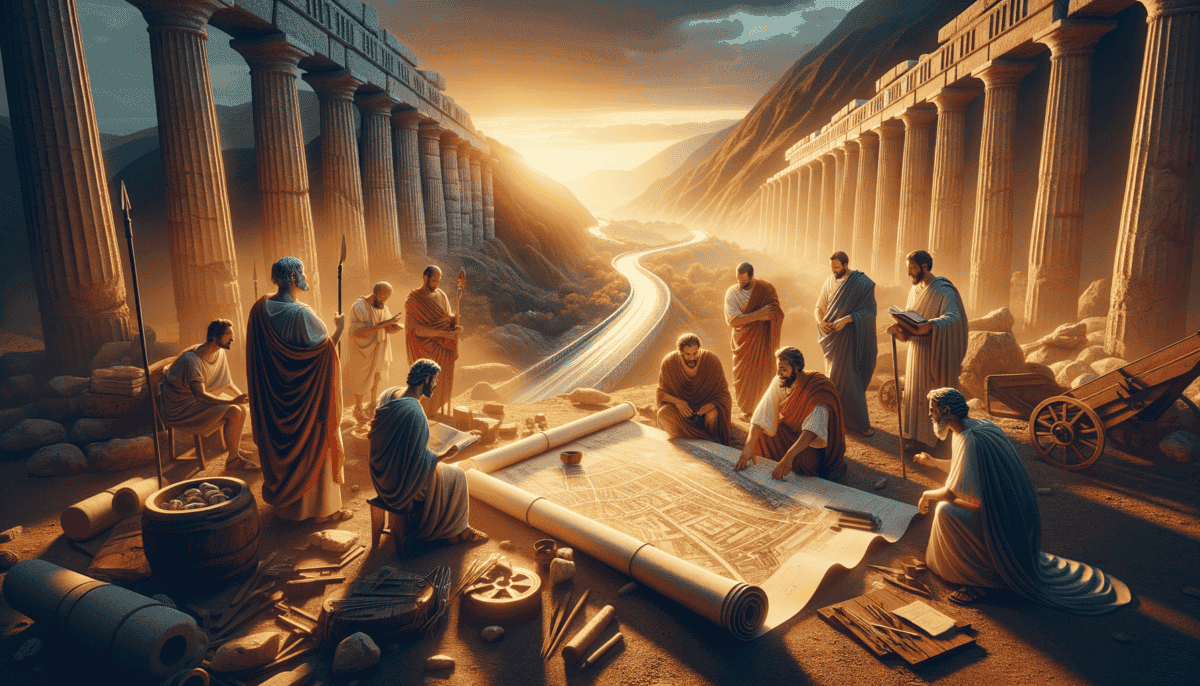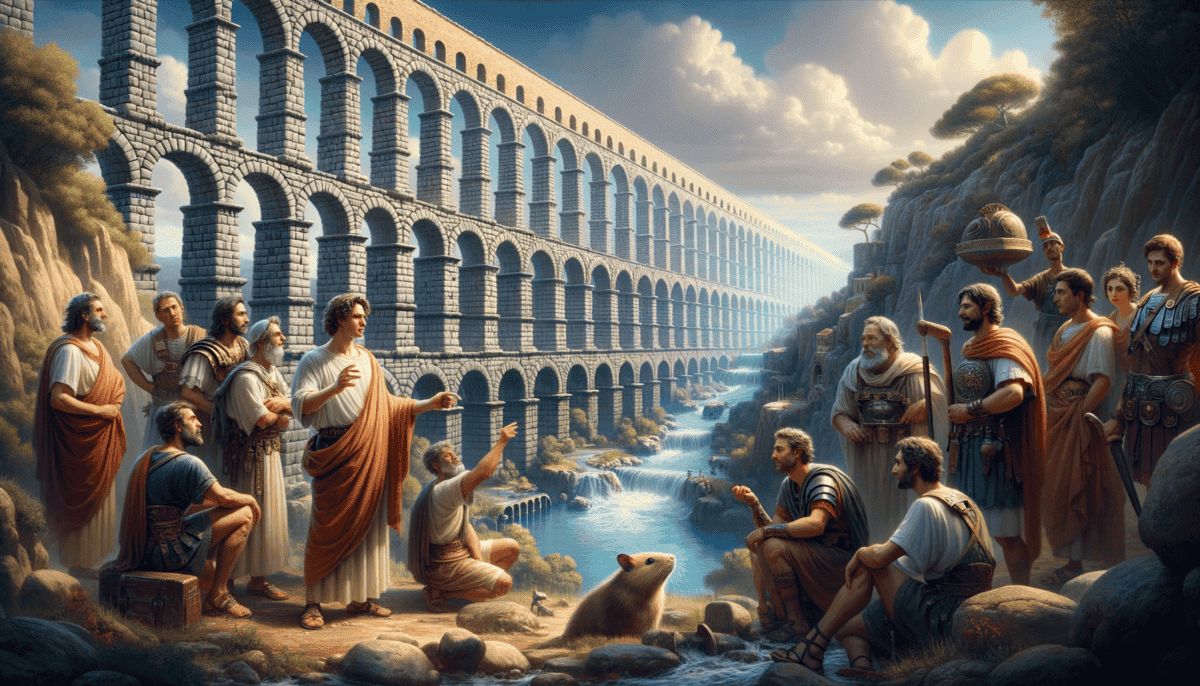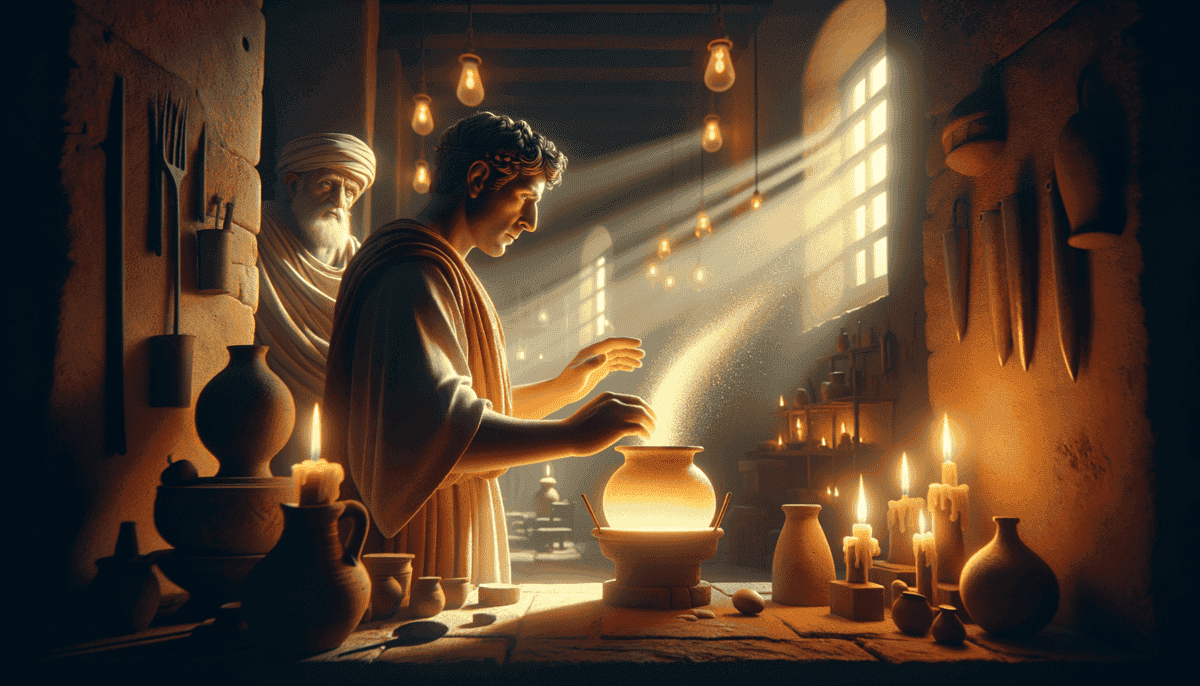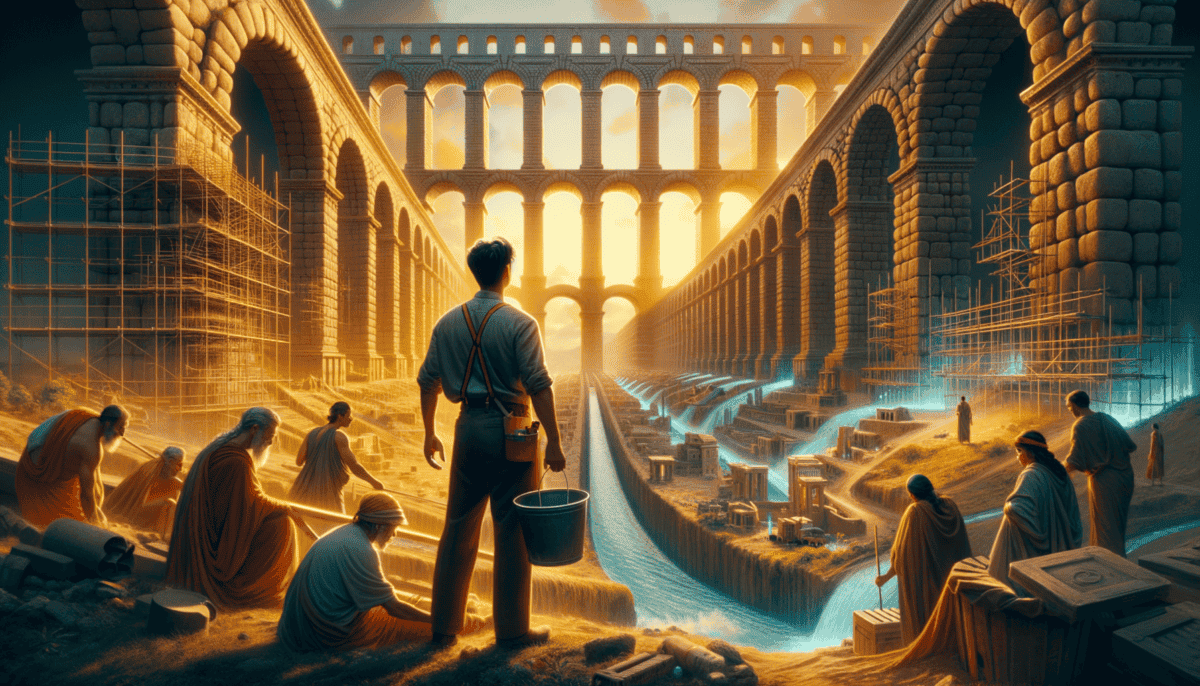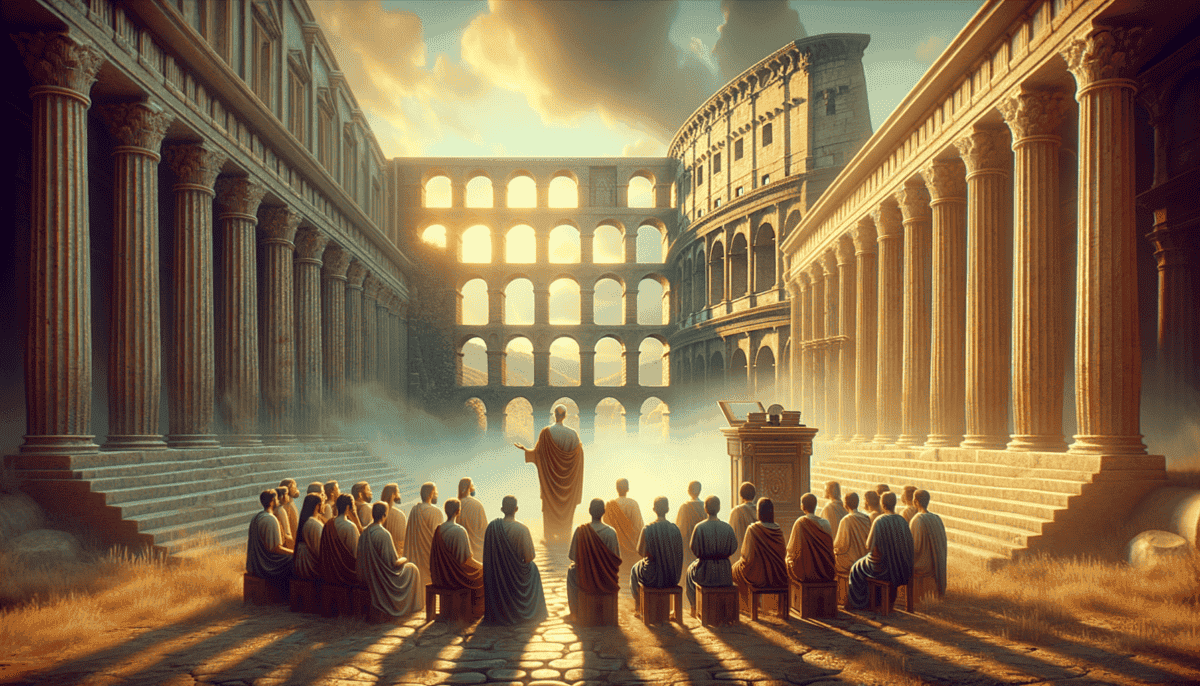The Young Inventor’s Dream
Marcus wiped the sweat from his forehead as he watched workers struggle to carry heavy water jugs up the steep hill. The hot Roman sun beat down on the busy street. At twelve years old, he already knew there had to be a better way.
"Why do they carry water like this every day?" Marcus asked his mentor, Flavius, an old engineer with kind eyes and gray hair.
Flavius smiled. "That's a good question, young one. Sometimes the simplest things need the biggest changes."
“Rome wasn’t built in a day, but it was built by dreamers like you, Marcus.” – Flavius
Marcus loved spending time with Flavius in his workshop. It was filled with interesting tools, drawings, and half-finished projects. Today, they sat at a wooden table covered with sketches.
"Look here," Flavius pointed to a drawing. "The Greeks started using pipes to move water. But we Romans can do even better!"
Marcus's eyes lit up. "Could we make the water flow uphill?"
"With the right engineering, water can flow anywhere," Flavius winked. "But first, you need to understand how water moves."
The First Challenge
The next day, Flavius gave Marcus his first real test. He had to design a small water channel to water the plants in the courtyard.
Marcus grabbed his wooden tablets and started drawing. His first try didn't work – the water just pooled in one spot. But Marcus didn't give up.
"Remember," Flavius said, watching Marcus work, "water always flows downhill. Use that to your advantage."
After three more tries, Marcus created something new. He made the channel slope gently downward, with little steps to slow the water's flow. The plants got just the right amount of water!
One evening, as they cleaned up the workshop, Marcus shared his biggest dream.
"I want to help build something that will last forever," he said. "Something that will make life better for everyone."
Flavius put his hand on Marcus's shoulder. "You've already started, my boy. You see problems and try to fix them. That's what great engineers do."
That night, Marcus couldn't sleep. His mind was full of ideas. He drew pictures of water flowing through pipes in the sky, of strong roads that could connect cities, and of tall buildings that touched the clouds.
A New Discovery
The next morning, Marcus rushed to the workshop early. He had an idea about using different materials to make stronger pipes.
"Look what I found!" Marcus held up some clay mixed with tiny rocks. "It's harder than regular clay!"
"Interesting," Flavius examined the mixture. "You might be onto something important."
Marcus spent the rest of the day testing different mixtures. Some crumbled, some cracked, but each failure taught him something new.
• Never give up after failing
• Learn from mistakes
• Keep asking questions
• Try new ideas
As the sun set over Rome's seven hills, Marcus looked at his city with new eyes. He saw not just buildings and streets, but possibilities. Every problem was a chance to invent something better.
"Tomorrow," he told himself, "I'll try again. And maybe, just maybe, I'll create something that changes everything."
The workshop grew quiet as darkness fell, but Marcus's mind was alive with ideas. This was just the beginning of his journey to become one of Rome's greatest engineers.
Roads to Everywhere
The morning sun cast long shadows across the dusty construction site where Marcus stood with his mentor Flavius. Today was special – they were joining the team building the Via Appia, Rome’s most important road! ️
“Why do we need such big roads?” Marcus asked, watching workers lay large stone blocks.
“Roads connect people, Marcus,” Flavius explained. “They help our soldiers march, traders sell goods, and families visit each other.”
“A road is like a story – it takes you on a journey and connects different places together.” – Flavius
The Road Building Challenge
Marcus met Julia, a smart girl whose father led the road builders. She showed him how they worked.
“First, we dig deep,” Julia explained. “Then we add layers of different rocks. It’s like making a sandwich!”
Marcus watched closely as the workers built the road layers:
• Big rocks on the bottom
• Medium rocks in the middle
• Small stones and sand on top
• Flat stones for the surface
Solving Problems Together
“We have a problem,” Julia said one day. “The road keeps getting muddy when it rains.”
Marcus remembered his water channel project. “What if we make the road slightly curved on top?” he suggested. “The rain would flow away instead of making puddles!”
Julia’s eyes brightened. “That’s brilliant! Let’s tell my father!” ⭐
The road builders tried Marcus’s idea. It worked! The curved road stayed dry even after heavy rain.
New Friends, New Ideas
More workers joined the project. Marcus met Lucius from Greece and Claudia from Spain. They shared stories about roads in their homelands.
“In Greece, we use different stones,” Lucius said. “They’re good for steep hills.”
“In Spain, we make roads wider for big carts,” Claudia added.
Marcus wrote down everything he learned in his tablets. Each day brought new discoveries!
A Big Test
One morning, Flavius had exciting news. “Marcus, we need your help. There’s a steep hill ahead, and the usual road design won’t work.”
Marcus thought about everything he’d learned. He remembered Lucius’s special stones and Julia’s layering technique. Then he had an idea!
“What if we cut steps into the hill first?” Marcus suggested. “Then we can build the road layers like stairs going up!”
The builders tried Marcus’s plan. It was hard work, but it worked perfectly! The road climbed the hill smoothly, and even heavy carts could use it easily.
More Than Just Stones
As the road grew longer, Marcus realized something important. “Roads aren’t just stone and sand,” he told Julia. “They’re like bridges between people.”
“You’re right,” Julia smiled. “Look how many new friends we’ve made building this road!”
Every evening, Marcus walked home on their new road, proud of what they’d built together. He touched the smooth stones and thought about all the people who would use this road for hundreds of years.
“Tomorrow,” he thought, “we’ll build more roads. And each one will make our world a little bit bigger.”
Always plan ahead
Work together with others
Learn from different people
Solve problems step by step
The sun set over the Via Appia, casting long shadows across the stone surface. Marcus knew this was just the beginning of his journey to help build Rome’s amazing network of roads.
Water of Life
Marcus wiped sweat from his forehead as he looked up at the tall stone arches rising against the blue sky. Building roads had taught him a lot, but now he faced an even bigger challenge – bringing water to Rome!
A New Adventure
“Water is like magic,” said Cornelia, the head water engineer. “It always wants to flow downhill. Our job is to help it reach the city.”
Marcus watched in amazement as workers built tall stone bridges called aqueducts. These would carry water from the mountains all the way to Rome!
The Big Problem
“We have trouble,” Cornelia said one morning. “The water won’t flow fast enough through our channels.”
Marcus remembered playing with toy boats as a child. “What if we make the channel slope down just a tiny bit?” he suggested. “Like a very gentle slide?”
“That’s clever thinking!” Cornelia smiled. “Let’s try it!”
Team Water Power
Marcus joined a special team of water engineers:
• Titus – The math expert
• Helena – The stone carver
• Marcus – The problem solver
“Water is tricky,” Titus explained. “Too fast, and it breaks the channels. Too slow, and it gets stuck.”
Helena showed Marcus how to carve perfect stone blocks. “The water path must be smooth,” she said. “Like a river made of stone.”
The Big Test
One day, they faced their biggest challenge yet – crossing a deep valley.
“We can’t go around it,” Cornelia said. “We must go over it!”
Marcus looked at his notes from road building. “What if we build arches?” he suggested. “Like we did for the roads, but much taller!”
“Sometimes the best way forward is up!” – Marcus
Building to the Sky
They worked hard to build giant arches. Each one had to be perfect! The water channel would sit on top, carrying fresh mountain water to Rome.
“Look how strong the arch shape is!” Helena showed Marcus. “It holds up the heavy stone and water!”
They spread the weight evenly
Get stronger when pressed down
Can be built very tall
Last for hundreds of years
Water Success!
Finally, the big day came to test their aqueduct. Everyone held their breath as they released the water at the top.
“Watch!” Cornelia pointed. The water flowed smoothly through the channel, across their tall arches, and down into the city below.
“We did it!” Marcus cheered. “Clean water for everyone!”
More Than Just Water
That evening, Marcus watched families filling their water jugs at the new fountain.
“You see that?” Cornelia smiled. “We’re not just building with stone and water. We’re helping people live better lives.”
Marcus nodded, already thinking about their next project. There were more cities that needed water, and he was ready to help build more amazing aqueducts!
The setting sun made the water sparkle like diamonds as it flowed through their creation. Marcus knew that this was just the beginning of his water engineering adventures.
The Concrete Revolution
Marcus stared at the strange gray mixture in his hands. It felt gritty but smooth. This wasn’t ordinary stone – it was something new and exciting! ️
A Strange Discovery
“What are you making, Marcus?” asked Helena, watching him mix ash from Mount Vesuvius with lime and water.
“I’m not sure yet,” Marcus smiled. “But look what happens when it dries!” He showed her a hardened chunk from yesterday’s experiment. It was strong as rock!
Not Everyone Likes New Ideas
“Nonsense!” grumbled Flavius, the head builder. “We’ve always used stone blocks. Why change now?”
But Marcus wouldn’t give up. He remembered what Cornelia taught him about trying new things.
“Sometimes the best ideas seem strange at first!” – Cornelia
The Big Test
Marcus mixed his special recipe:
• White lime from crushed seashells
• Fresh water
• Small rocks and sand
“It’s like making a cake,” he told Helena, “but this cake turns into stone!”
A Happy Accident
One day, some of Marcus’s mixture spilled into seawater. The next morning, it was harder than ever!
“Look!” he shouted excitedly. “The sea made it stronger!”
Cornelia examined the sample. “Marcus, you might have just solved our biggest problem – building in the sea!”
Proving It Works
Marcus decided to show everyone how good his concrete was. He built two small walls – one with traditional stone blocks and one with his concrete.
“Now we wait,” he said. After a month in the rain and sun, the concrete wall was still perfect!
Can be shaped into any form
Gets stronger over time
Works underwater
Cheaper than cut stone
Building Something Big
Finally, Flavius agreed to try Marcus’s concrete on a real project – a new harbor wall.
“If this works,” Cornelia said, “we can build bigger things than ever before!”
Workers poured the concrete into wooden forms. Day after day, it grew stronger. Even the waves couldn’t hurt it!
Success at Last
“I was wrong,” Flavius admitted, tapping the solid harbor wall. “This concrete of yours is remarkable!”
Marcus beamed with pride. His strange mixture was changing how Rome built things. Now they could make bigger buildings, stronger bridges, and safer harbors.
That night, looking at the sunset reflecting off his concrete wall, Marcus dreamed of all the amazing things they could build next. The concrete revolution had begun! ✨
Building an Empire
The morning sun sparkled on Rome’s newest wonder – a massive dome made of Marcus’s special concrete. People stood in awe, pointing up at the sky through the giant round opening. ️
A Builder’s Dream
“We did it, Helena!” Marcus beamed. “The biggest dome ever built!”
Helena touched the smooth concrete walls. “And it’s all thanks to your special recipe.”
Big Dreams, Big Buildings
“What should we build next?” Marcus asked his team. Ideas poured in like fresh concrete:
• Tall buildings with many floors
• Huge theaters for thousands of people
• Strong walls to protect cities
“With our concrete, we can build anything!” shouted young Claudius, Marcus’s newest student.
Not Just Buildings
Marcus combined all his inventions to make Rome better:
“Roads carry people, aqueducts carry water, and concrete carries our dreams to new heights!” – Marcus
Teaching Others
People came from far away to learn from Marcus. He showed them how to:
Make perfect concrete ️
Build strong arches
Design clever water systems
Plan straight roads ️
A Special Project
“Marcus!” called Emperor Hadrian. “I want the biggest dome ever built. Can you do it?”
Marcus looked at his plans and smiled. “With our Roman concrete, anything is possible!”
Working Together
Everyone helped with the huge project:
Helena managed the workers ♀️
Claudius mixed the concrete perfectly
Cornelia checked every measurement
Even old Flavius came to help!
Rome Grows Stronger
As the dome rose higher, Marcus saw how his inventions changed Rome:
Clean water flowed everywhere through aqueducts
Strong roads connected distant places
Huge buildings reached toward the sky
Mighty harbors welcomed ships from far away
A Teacher’s Pride
“Look at what you’ve built,” Cornelia said proudly. “Not just buildings, but a better world.”
Marcus watched Claudius teach a group of young builders. “And now others will build even more amazing things!”
That evening, standing under his giant dome, Marcus felt like he could touch the stars. Roman engineering was changing the world, one invention at a time. ⭐
A Legacy of Innovation
Years passed, and Marcus’s hair turned grey like the stones of Rome. But his eyes still sparkled with the same curiosity he had as a young builder.
The Master’s Workshop
Marcus’s workshop buzzed with activity. Young engineers from across the empire came to learn. Today, they gathered around a special model.
“This,” Marcus smiled, pointing to his creation, “is the future of Rome.” ️
Teaching the Next Generation
Claudius, now a master builder himself, stood beside his old teacher. “Tell them about your first invention, Marcus!”
Marcus laughed. “Oh, that water wheel! It barely worked. But it taught me something important – never give up!”
“Every broken stone teaches us how to build better,” Marcus told his students. “That’s how Rome grew strong.”
The Greatest Gifts
Marcus’s inventions changed how people lived:
• Clean water for everyone
• Strong buildings that lasted forever
• New tools that made work easier
A Special Surprise
Helena burst into the workshop. “Marcus! Come quickly!”
Outside, a crowd gathered. The Emperor himself stood waiting.
“Marcus,” the Emperor announced, “your inventions have made Rome greater than ever. We honor you as Rome’s Master Builder!”
Passing the Torch
Marcus looked at his students’ shining faces. “The future belongs to you now. Build wisely, build strongly, build for everyone.”
Claudius stepped forward. “We promise to make you proud, teacher.”
The Final Project
Together, Marcus and his students designed something special – a great library to hold all their building knowledge.
“Now,” Marcus said, “our ideas will live forever.”
Forever Rome
Years later, visitors still came to see Marcus’s works:
Strong roads still carried travelers ✈️
Mighty aqueducts still flowed
Great domes still touched the sky
And young builders still learned from his ideas
Marcus’s last student wrote: “He taught us more than how to build with stone and concrete. He taught us to build with our hearts and minds.”
A Builder’s Sunset
One evening, Marcus stood on his favorite hill. Below spread the greatest city in the world – a city he helped build.
“What do you see?” Helena asked softly.
Marcus smiled. “I see tomorrow. I see young builders making new wonders. I see Rome growing stronger and bigger. And I see our ideas spreading across the world.”
And he was right. Even today, thousands of years later, we still use many of Marcus’s clever Roman inventions. Every road, bridge, and building tells his story – the story of a curious boy who dreamed of making the world better, one invention at a time. ⭐


